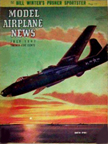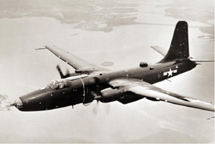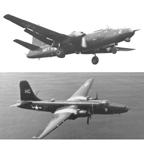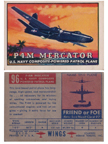July, 1947

Martin P4M "Mercator"
Model Airplane News Cover Art for July, 1947
by Jo Kotula
Click to Enlarge
The Martin P4M Mercator was a martime reconnaissance aircraft built by the Glenn L. Martin Company. The Mercator was an unsuccessful contender for a United States Navy requirement for a long-range maritime patrol bomber. It saw a limited life as a long-range electronic reconnaissance aircraft. It was one of a number of Navy experiments in composite power using a combination of piston engines and turbojets.


Martin P4M "Mercator"
Click to Enlarge
Work began on the Model 219 in 1944, as a replacement for the PB4Y Privateer long range patrol bomber, optimised for long range minelaying missions, with the first flight in October of 1946. The mercator was a large and complicated aircraft, powered by two 28-cylinder radial engines. To give a boost during takeoff and combat, two turbojets were fitted in the rear of the enlarged engine nacelles, the intakes being beneath and behind the radial engines. The jets, like those on most other piston/jet hybrids, burned gasoline, not jet fuel. These experiments in composite power were the brainchild of Admiral John S. McCain (grandfather of the 2008 presidential candidate). Jo Kotula must have also been fascinated with composite power because he featured it on five covers in addition to this one:
- The Curtiss X15C was on the cover of the October, 1947 issue.
- The Grumman XTBF3-1 Guardian was on the cover of the June, 1948 issue.
- The North American Savage, on the cover of the January, 1952 issue
- The Ryan FR-1 "Fireball" was featured twice, on the cover of the Feburuary, 1946 and May, 1947 issues
- The Martin P4M Mercator, on the cover of the July, 1947 issue
The P4M had Heavy defensive armament, with two 20 mm cannons in an Emerson nose turret and a Martin tail turret, and two 50 caliber machine guns in a Martin dorsal turret. The bomb-bay was, like British practice, long and shallow rather than the short and deep bay popular in American bombers. This gave greater flexibility in payload, including long torpedoes, bombs, mines, depth charges or extended-range fuel tanks. The US Navy chose the smaller, simpler and cheaper P2V Neptune for the maritime patrol requirement, but nineteen P4Ms were ordered in 1947 for high-speed minelaying purposes. In 1951 these were modified for the electronic reconnaissance (or SIGINT, for signals intelligence) mission as the P4M-1Q, to replace the PB4Y-2 Privateer. The crew was increased to 14 and later 16 to operate all the surveillance gear, and the aircraft was fitted with a large number of different antennas.
Missions were flown from the Philippines (and, later, Japan) by Fleet Air Reconnaissance Squadron One (VQ-1) along the Chinese borders and along the eastern Russian coasts, and were of a highly secret nature; the aircraft masqueraded as regular P2V Neptunes in radio communications. One Mercator was shot down by Chinese fighters in 1956, while another was attacked by two fighters in 1959 but escaped with injury to one crewman. The aircraft were also operated out of Morocco where one aircraft was intercepted near Ukrainian airspace by Soviet MiG's. It escaped by flying under jet power but ran out of fuel and crashed into Mediterranean Sea with the loss of all crew. The Mercators were replaced by the EA-3 Skywarrior, which being carrier-based had a greater degree of flexibility. Final withdrawal from service was in 1960, and all of the remaining P4Ms were scrapped.
In addition to the cover of Model Airplane News, this airplane was also featured in the WINGS "Friend or Foe" trading card series of the early 1950s

Trading card representation of the Martin P4M "Mercator".
Click Here to see all 200 cards in the series
Click to Enlarge
Click Here for more information about the Martin P4M "Mercator".

Click to go back and select another cover.
Counter for the Entire Site (not just this page..)
Home | About Lindy | Last Week's Reviews | Upcoming Events | 1940s Collecibles
The Guide - Establishments - Travel - Accessories
Music | Links | Photo Gallery | Extras | Contact